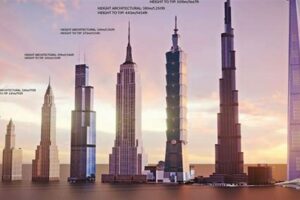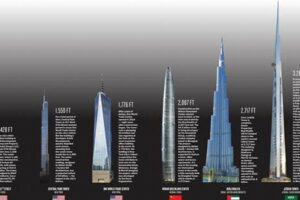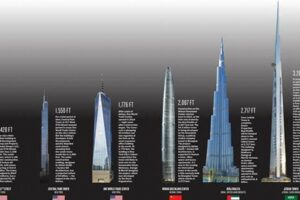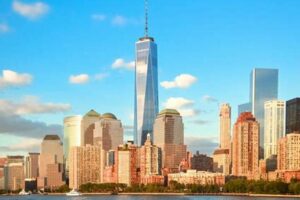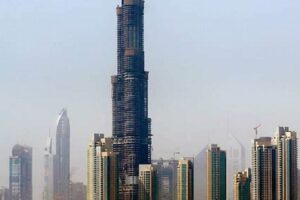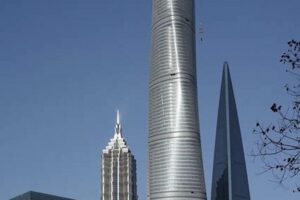The Burj Khalifa, located in Dubai, United Arab Emirates, is the tallest skyscraper in the world. Completed in 2010, the Burj Khalifa stands at an impressive 828 meters (2,717 feet) tall and has 163 floors. It is an iconic landmark and a testament to human ingenuity and engineering prowess.
The Burj Khalifa offers breathtaking views of Dubai and its surrounding areas. It is home to luxury residences, offices, a hotel, and a variety of restaurants and entertainment venues. The building has become a popular tourist destination and a symbol of Dubai’s economic growth and ambition.
The construction of the Burj Khalifa was a complex and challenging undertaking. It required the use of innovative construction techniques and materials, and the project employed thousands of workers from around the world. The building’s design was inspired by the Hymenocallis flower, and its exterior features a series of setbacks that give it a distinctive appearance.
1. Height
The height of 828 meters (2,717 feet) is the defining characteristic that makes the Burj Khalifa the tallest skyscraper in the world. This extraordinary height:
- Engineering Marvel: Constructing a building of this height required innovative engineering solutions and advanced construction techniques. The Burj Khalifa’s structural design incorporates a reinforced concrete core and a steel exterior, enabling it to withstand high winds and seismic activity.
- Breathtaking Views: The height of the Burj Khalifa offers unparalleled panoramic views of Dubai and its surroundings. Visitors can enjoy breathtaking vistas from observation decks located at various levels, including the “At the Top” deck on the 124th floor.
- Vertical Community: The Burj Khalifa’s height accommodates a diverse community within a single structure. It houses luxury residences, offices, a hotel, and various amenities, creating a vertical neighborhood that caters to different lifestyles.
- Architectural Icon: The Burj Khalifa’s distinctive design and sheer height have made it an architectural icon recognized worldwide. Its sleek exterior and setbacks resemble a blooming desert flower, paying homage to the region’s cultural heritage.
In summary, the height of 828 meters (2,717 feet) is not just a number but a testament to human ambition and technological advancement. It embodies the engineering prowess, architectural grandeur, and global recognition that make the Burj Khalifa the tallest skyscraper in the world.
2. Floors
The Burj Khalifa’s 163 floors are an integral aspect of its status as the tallest skyscraper in the world. This exceptional number of floors allows for various functional spaces and amenities within a single structure, contributing to its vertical community concept and catering to diverse needs:
- Vertical Zoning: The 163 floors enable efficient vertical zoning, allowing for distinct sections dedicated to residential units, office spaces, a hotel, and various amenities. This zoning optimizes space utilization and creates a self-contained ecosystem within the skyscraper.
- Diverse Community: With 163 floors, the Burj Khalifa accommodates a diverse community of residents, workers, and visitors. This vertical neighborhood fosters a sense of community and provides a range of living, working, and leisure options within one iconic structure.
- Panoramic Views: The higher floors of the Burj Khalifa offer unparalleled panoramic views of Dubai and its surroundings. Residents and visitors can enjoy breathtaking vistas from the comfort of their homes or from observation decks, creating a unique and exclusive living experience.
In conclusion, the 163 floors of the Burj Khalifa are not merely a number but a fundamental element that contributes to its status as the tallest skyscraper in the world. They allow for efficient space utilization, foster a diverse community, and provide unparalleled views, making the Burj Khalifa an architectural marvel and a global icon.
3. Location
The location of the Burj Khalifa in Dubai, United Arab Emirates, plays a crucial role in its status as the tallest skyscraper in the world. Dubai’s strategic position at the crossroads of global trade and tourism, coupled with its ambitious vision for economic growth, has made it an ideal setting for such a remarkable architectural achievement.
Dubai’s government has consistently invested in infrastructure and development projects, creating a business-friendly environment that attracts investors and professionals from around the world. This supportive ecosystem has fostered a competitive landscape where developers are encouraged to push the boundaries of architectural innovation.
Furthermore, Dubai’s geographical location offers several advantages for constructing a skyscraper of such magnitude. The city’s proximity to major shipping lanes and its position as a regional hub for aviation provide convenient access to materials and labor. Additionally, Dubai’s relatively flat terrain and stable geological conditions minimize the engineering challenges associated with building on unstable ground.
In summary, the location of the Burj Khalifa in Dubai, United Arab Emirates, is not merely coincidental but a strategic choice that leverages the city’s economic, infrastructural, and geographical advantages. This combination of factors has made Dubai an ideal setting for the construction and continued success of the tallest skyscraper in the world.
4. Architect
Adrian Smith, a renowned architect and designer, played a pivotal role in the creation of the Burj Khalifa, the tallest skyscraper in the world. His expertise and innovative approach were instrumental in pushing the boundaries of architectural design and engineering.
Smith’s vision for the Burj Khalifa was to create a structure that would redefine the skyline of Dubai and become an iconic landmark. He drew inspiration from traditional Islamic architecture, incorporating elements such as the pointed arches and geometric patterns found in mosques. The building’s form was also influenced by the Hymenocallis flower, resulting in a distinctive and visually striking design.
Smith’s attention to detail and commitment to sustainability were evident throughout the Burj Khalifa’s construction. He implemented innovative techniques to reduce the building’s environmental impact, including the use of high-performance glass to minimize heat gain and energy consumption. The building’s aerodynamic shape also helps to reduce wind resistance and sway.
The Burj Khalifa’s success is a testament to Adrian Smith’s architectural prowess and his ability to translate vision into reality. His innovative design and commitment to sustainability have created a building that is not only the tallest in the world but also an architectural marvel that continues to inspire and amaze.
5. Construction
The construction of the Burj Khalifa, which spanned from 2004 to 2010, is inextricably linked to its status as the tallest skyscraper in the world in 2020. This ambitious project required meticulous planning, innovative engineering, and a dedicated workforce to bring it to fruition.
- Advanced Engineering Techniques: The construction of the Burj Khalifa pushed the boundaries of engineering, employing cutting-edge techniques to achieve its unprecedented height. Engineers developed innovative methods for pumping concrete to extreme heights and designed a reinforced concrete core to withstand the immense weight and wind forces.
- Specialized Workforce: The construction of the Burj Khalifa required a highly skilled and specialized workforce. Thousands of workers from around the world collaborated on this project, bringing their expertise in various construction disciplines to ensure its successful completion.
- Logistical Challenges: Constructing a skyscraper of such magnitude presented significant logistical challenges. Managing the flow of materials, equipment, and personnel required careful coordination and efficient supply chain management.
- Safety Measures: Ensuring the safety of workers during the construction of the Burj Khalifa was paramount. Stringent safety protocols and measures were implemented to minimize risks and protect the well-being of those involved in this complex project.
The successful construction of the Burj Khalifa within the span of 2004-2010 is a testament to the ingenuity, collaboration, and unwavering determination of those involved. Their efforts resulted in the creation of an architectural marvel that continues to captivate and inspire the world.
6. Cost
The construction of the Burj Khalifa, the tallest skyscraper in the world in 2020, was a colossal undertaking involving cutting-edge engineering, innovative techniques, and a vast workforce. Naturally, such an ambitious project came with a substantial price tag of approximately $1.5 billion.
- Advanced Materials and Technology: Constructing a building of this magnitude required the use of advanced materials and technologies, such as high-strength concrete, specialized glass, and wind-resistant steel. These materials contributed significantly to the building’s structural integrity and overall cost.
- Skilled Workforce: The Burj Khalifa’s construction involved a highly skilled workforce, including engineers, architects, construction managers, and specialized laborers. The expertise and precision required for such a complex project commanded a significant portion of the overall cost.
- Logistical Challenges: Erecting a skyscraper of this height presented logistical challenges, including the transportation and handling of massive building components and the coordination of thousands of workers. These logistical complexities further contributed to the project’s cost.
- Safety and Regulations: Ensuring the safety of workers and adhering to strict building codes and regulations were paramount during the construction of the Burj Khalifa. Implementing comprehensive safety measures and complying with building standards added to the overall cost.
The $1.5 billion cost of the Burj Khalifa reflects not only the financial investment but also the confluence of advanced engineering, innovative techniques, and a skilled workforce. This investment has resulted in an architectural marvel that has redefined the skyline of Dubai and continues to inspire awe and admiration around the world.
7. Materials
The construction of the tallest skyscraper in the world in 2020, the Burj Khalifa, relied heavily on the use of three primary materials: concrete, steel, and glass. These materials played a crucial role in achieving the building’s extraordinary height and structural integrity.
- Concrete: Concrete is a composite material composed of cement, aggregates (such as sand and gravel), and water. It is known for its strength, durability, and ability to be molded into various shapes. In the case of the Burj Khalifa, concrete was used to construct the building’s massive core, which provides the primary structural support. The concrete core is reinforced with steel bars to enhance its strength and resistance to bending.
- Steel: Steel is an alloy of iron and carbon, known for its high strength-to-weight ratio, durability, and resistance to corrosion. In the Burj Khalifa, steel was primarily used for the building’s exterior framework. The steel frame provides support to the concrete core and helps to distribute the weight of the building evenly. Additionally, steel was used for the construction of the building’s curtain wall, which consists of glass panels supported by a steel grid.
- Glass: Glass is a transparent or translucent material made from the fusion of silica and other ingredients. It is known for its ability to transmit light while providing thermal insulation. In the Burj Khalifa, glass was used extensively for the building’s curtain wall, allowing for natural light to penetrate deep into the interior while providing panoramic views of the surrounding cityscape.
The combination of concrete, steel, and glass in the construction of the Burj Khalifa showcases the advancements in material science and engineering. These materials enabled the construction of a building that is not only the tallest in the world but also an architectural marvel that continues to inspire and captivate.
8. Purpose
The Burj Khalifa, the tallest skyscraper in the world in 2020, serves a multifaceted purpose, encompassing residential, commercial, hotel, and entertainment functions. This diverse utilization optimizes the building’s vast space and caters to a wide range of needs, enhancing its overall appeal and functionality.
- Residential: The Burj Khalifa houses over 1,000 luxury residential units, offering breathtaking views of Dubai and its surroundings. These units range from one-bedroom apartments to penthouses, providing a unique and exclusive living experience at unparalleled heights.
Implications: The residential component contributes to the building’s status as a vertical community, creating a self-contained ecosystem where residents can live, work, and enjoy amenities within the same structure.
- Commercial: The Burj Khalifa accommodates numerous office spaces, catering to businesses and professionals from various industries. Its prime location and state-of-the-art facilities make it an attractive choice for companies seeking a prestigious and efficient work environment.
Implications: The commercial aspect of the building fosters economic growth and innovation, attracting businesses and entrepreneurs to Dubai’s thriving economy.
- Hotel: The Burj Khalifa is home to the Armani Hotel Dubai, a luxurious hotel occupying several floors of the building. Guests can indulge in world-class amenities, fine dining, and exceptional service while enjoying unparalleled views of the city.
Implications: The hotel component adds to the building’s allure, attracting tourists and business travelers seeking an unforgettable and opulent stay.
- Entertainment: The Burj Khalifa offers a range of entertainment options, including the “At the Top” observation deck, which provides panoramic views of Dubai from various levels. Visitors can also enjoy fine dining at the Atmosphere restaurant, located on the 122nd floor.
Implications: The entertainment aspect of the building enhances its appeal as a tourist destination, attracting visitors from around the world to experience its breathtaking views and world-class amenities.
In conclusion, the diverse purpose of the Burj Khalifa, encompassing residential, commercial, hotel, and entertainment functions, contributes to its status as the tallest skyscraper in the world in 2020. This multifaceted utilization optimizes the building’s space, caters to a wide range of needs, and enhances its overall appeal, making it a true architectural marvel and a symbol of Dubai’s economic growth and global recognition.
9. Awards
The Guinness World Record for tallest building is a prestigious accolade bestowed upon the Burj Khalifa, solidifying its status as the tallest skyscraper in the world in 2020. This award is not merely a recognition of the building’s physical height but also a testament to the architectural ingenuity, engineering prowess, and construction expertise that brought this extraordinary structure to life.
The Guinness World Record serves as an objective and widely recognized benchmark for architectural achievements. By holding this record, the Burj Khalifa has gained global prominence and become an iconic symbol of human ambition and innovation. The award has not only enhanced the building’s reputation but also contributed to Dubai’s position as a leading destination for tourism, business, and investment.
Beyond its symbolic value, the Guinness World Record for tallest building has practical significance as well. It attracts visitors from around the world eager to witness the grandeur of this architectural marvel firsthand. The observation decks within the Burj Khalifa offer breathtaking panoramic views, making it a popular tourist attraction. Additionally, businesses and organizations seek to establish their presence in the tallest building in the world, recognizing the prestige and visibility it brings.
In conclusion, the Guinness World Record for tallest building is an integral component of the Burj Khalifa’s identity as the tallest skyscraper in the world in 2020. This award not only signifies architectural excellence but also contributes to the building’s global recognition, economic impact, and enduring legacy as a testament to human ingenuity.
Frequently Asked Questions About the Tallest Skyscraper in the World 2020
This section addresses common questions and misconceptions surrounding the Burj Khalifa, the tallest skyscraper in the world in 2020, providing comprehensive and informative answers.
Question 1: What factors contributed to the Burj Khalifa’s ability to reach such an extraordinary height?
Answer: The Burj Khalifa’s exceptional height was achieved through a combination of advanced engineering techniques, innovative construction methods, and the use of high-strength materials. Engineers employed a reinforced concrete core and a steel exterior to withstand the immense weight and wind forces. Additionally, the building’s aerodynamic shape helped to minimize wind resistance and sway.
Question 2: How does the Burj Khalifa’s design ensure the safety and comfort of its occupants during high winds and seismic activity?
Answer: The Burj Khalifa’s structural design incorporates cutting-edge technology and materials to ensure the safety of its occupants. The building’s reinforced concrete core and steel exterior provide exceptional strength and stability, while advanced damping systems minimize vibrations caused by high winds and seismic activity. Additionally, the building’s aerodynamic shape helps to reduce wind resistance and sway.
Question 3: What measures were taken to address the challenges of constructing a building of such immense height?
Answer: The construction of the Burj Khalifa required meticulous planning and innovative engineering solutions to overcome the challenges posed by its unprecedented height. Engineers developed specialized techniques for pumping concrete to extreme heights and employed advanced construction methods to ensure the structural integrity of the building. Additionally, a highly skilled workforce and stringent safety measures were essential for the successful completion of this ambitious project.
Question 4: How does the Burj Khalifa’s design promote sustainability and energy efficiency?
Answer: The Burj Khalifa incorporates several sustainable design features to reduce its environmental impact and promote energy efficiency. The building’s exterior glass panels are coated with a reflective film to minimize heat gain, while an automated lighting system adjusts to natural light levels to reduce energy consumption. Additionally, the building utilizes a rainwater harvesting system to collect and reuse rainwater for irrigation and other non-potable purposes.
Question 5: How does the Burj Khalifa contribute to the economic and cultural landscape of Dubai?
Answer: The Burj Khalifa is not only an architectural marvel but also a significant contributor to Dubai’s economy and cultural identity. The building has become an iconic landmark, attracting tourists from around the world and enhancing the city’s global recognition. Additionally, the Burj Khalifa serves as a hub for businesses and organizations, providing premium office spaces and amenities that support economic growth and innovation.
Question 6: What are the key lessons learned from the construction and operation of the Burj Khalifa that can be applied to future high-rise developments?
Answer: The Burj Khalifa’s construction and operation have provided valuable lessons that can guide future high-rise developments. These lessons include the importance of advanced engineering techniques, sustainable design principles, and meticulous planning. Additionally, the project has highlighted the need for collaboration between architects, engineers, and construction professionals to achieve ambitious architectural feats.
In conclusion, the Burj Khalifa’s status as the tallest skyscraper in the world in 2020 is a testament to human ingenuity, engineering prowess, and architectural innovation. Through its exceptional design, sustainable features, and economic impact, the Burj Khalifa continues to captivate and inspire, solidifying its place as an architectural icon and a symbol of Dubai’s global prominence.
Transition to the next article section:
Tips for Maximizing the Experience of the Tallest Skyscraper in the World 2020
Visiting the tallest skyscraper in the world in 2020, the Burj Khalifa, is an experience that combines awe-inspiring architecture with breathtaking views. Here are a few tips to help you make the most of your visit:
Tip 1: Book Your Tickets in Advance: Due to its popularity, it’s highly recommended to book your tickets for the Burj Khalifa’s observation decks well in advance, especially during peak tourist seasons. This will guarantee your entry and allow you to choose your preferred time slot.
Tip 2: Arrive Early: To avoid queues and ensure a smooth entry, plan to arrive at the Burj Khalifa at least 15-20 minutes before your scheduled time slot. This will give you ample time to go through security checks and make your way to the observation decks.
Tip 3: Choose the Right Observation Deck: The Burj Khalifa offers two observation decks: “At the Top” on the 124th and 125th floors, and “At the Top SKY” on the 148th, 125th, and 124th floors. “At the Top” offers stunning views of the city and surrounding areas, while “At the Top SKY” provides an even more exclusive and immersive experience with panoramic views from higher floors.
Tip 4: Visit During Sunset or Nighttime: The Burj Khalifa offers a truly magical experience during sunset and nighttime. As the sun sets, the city transforms into a sea of twinkling lights, creating a breathtaking panorama. Nighttime visits also offer stunning views of the city’s illuminated skyline.
Tip 5: Take Your Time and Enjoy the Views: Once you reach the observation decks, take your time to soak in the breathtaking views. Don’t hesitate to walk around and explore different angles of the city. There are designated areas for photography where you can capture memorable shots.
Tip 6: Explore the Dubai Mall and Surroundings: The Burj Khalifa is located in the heart of Dubai’s downtown area, adjacent to the Dubai Mall, one of the largest shopping malls in the world. Before or after your visit to the Burj Khalifa, take some time to explore the mall and its numerous shops, restaurants, and entertainment options.
Summary: By following these tips, you can maximize your experience of the tallest skyscraper in the world in 2020, the Burj Khalifa. From pre-planning your visit to making the most of your time at the observation decks, these tips will help you create lasting memories of this architectural marvel.
As you plan your visit, keep in mind that the Burj Khalifa is more than a skyscraper; it’s an iconic symbol of Dubai’s ambition and a testament to human ingenuity. By following these tips, you can fully appreciate the grandeur of this architectural masterpiece and enjoy an unforgettable experience.
Conclusion
The Burj Khalifa, completed in 2010 and standing at an impressive 828 meters (2,717 feet) tall, continues to reign as the tallest skyscraper in the world. Its exceptional height, innovative design, and unparalleled views have made it an architectural marvel and a symbol of Dubai’s economic growth and global recognition.
The construction of the Burj Khalifa was a testament to human ingenuity and engineering prowess. The building’s structural design, materials, and construction techniques pushed the boundaries of architectural possibility. Its design was inspired by the Hymenocallis flower, and its exterior features a series of setbacks that give it a distinctive appearance.
Beyond its architectural significance, the Burj Khalifa is a vibrant hub of residential, commercial, hotel, and entertainment spaces. It is home to luxury residences, offices, a hotel, and a variety of restaurants and entertainment venues. The building has become a popular tourist destination and a symbol of Dubai’s economic growth and ambition.
The Burj Khalifa stands as a reminder of the human spirit’s ability to achieve extraordinary feats. It is a testament to the power of innovation, collaboration, and the unwavering pursuit of excellence. As we look to the future, the Burj Khalifa will continue to inspire and captivate, serving as a symbol of architectural achievement and a source of pride for Dubai and the world.


